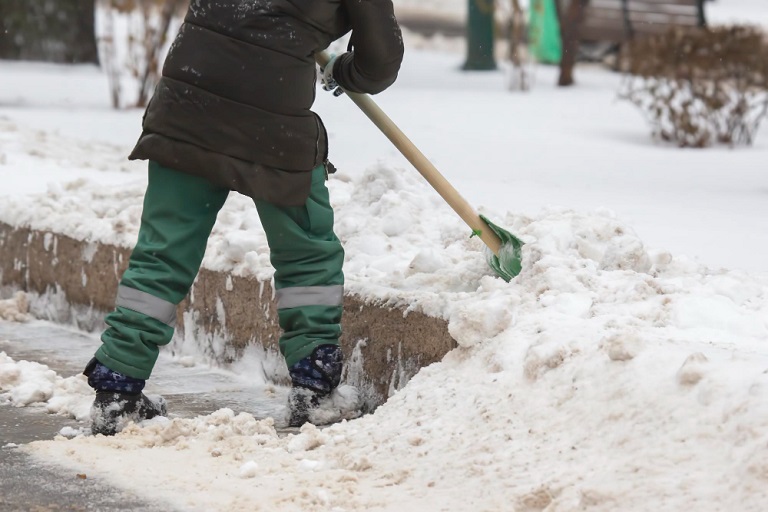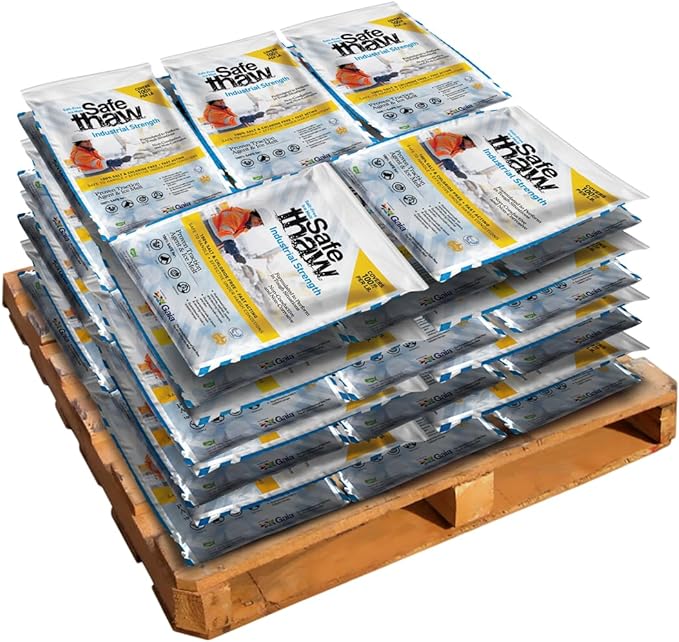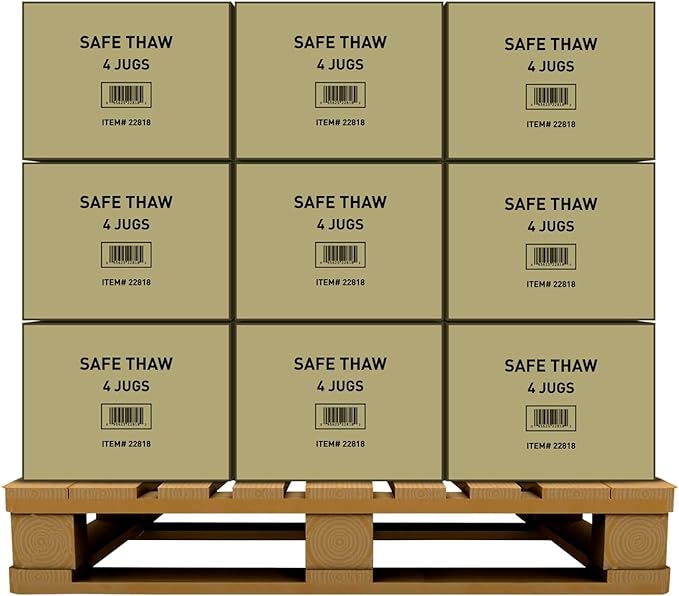How To Protect Your Concrete Driveway From Salt Damage

The winter roads can be harsh and unforgiving. Using salt for snow is a popular way of cleaning up the slush that piles up on your driveway after a snowstorm, but if you use too much of it or don’t take steps to protect your concrete from salt damage, then you could end up with unsightly pitting and other serious problems. Fortunately, there are ways to prevent this from happening—and we’re here to tell you how!
How to Protect Your Concrete Driveway From Salt Damage
Winter can be tough on concrete driveways, especially when deicing salts are used to keep surfaces clear of ice. While effective in melting snow, salts like sodium chloride can cause significant damage to concrete over time. From surface scaling to structural weakening, salt damage poses a threat to the durability and appearance of your driveway. By understanding the effects of salt, identifying early warning signs, and implementing preventive measures, you can protect your investment and maintain a safe, long-lasting driveway.
Understanding the Mechanisms of Salt-Induced Concrete Deterioration
Deicing salts work by lowering the freezing point of water, making it easier to melt ice. However, this process can harm concrete surfaces.
Freeze-Thaw Cycles and Concrete Damage
When water mixed with salt penetrates the pores of concrete and freezes, it expands. This expansion exerts pressure on the concrete, causing internal cracking and surface flaking. With repeated freeze-thaw cycles, the damage worsens, leading to scaling and spalling.
Corrosive Effects of Sodium Chloride
Sodium chloride is the most common deicing salt, but it accelerates corrosion in steel reinforcements within the concrete. Over time, this corrosion compromises the structural integrity of your driveway.
Why Salt-Free Ice Melt is Safer
Using salt free ice melt eliminates these risks. Products like Safe Thaw are designed to melt ice effectively without causing internal stress or corrosion in concrete, ensuring long-term durability.
Identifying Early Signs of Salt Damage on Concrete Surfaces
Recognizing salt damage early can save you from costly repairs or replacements.
Flaking and Scaling
One of the first signs of salt damage is surface flaking, where small pieces of the concrete break away. This often appears as a rough or uneven texture on the surface.
Discoloration
Salt can leave white or grayish stains on concrete, often mistaken for dirt. This discoloration, known as efflorescence, occurs when salts leach to the surface.
Fine Cracks
Look for small cracks that may appear harmless initially. These cracks allow water and salt to penetrate deeper into the concrete, exacerbating the damage.
Prompt Action is Crucial
Addressing these issues early with products like the best concrete resurfacer can restore your driveway’s appearance and prevent further deterioration.
Alternative Deicing Methods to Minimize Concrete Damage
Reducing reliance on traditional salts is key to preserving your driveway. Here are some safer options:
Non-Corrosive Deicing Agents
- Potassium Chloride: Effective at moderate temperatures and less harmful than sodium chloride. However, this option is not free from drawbacks.
- Salt-Free Ice Melt: Chloride-free products like Safe Thaw provide excellent ice-melting capabilities without harming concrete or the environment.
Mechanical Methods
Shoveling snow promptly after a snowfall prevents ice formation and reduces the need for deicing agents. Use a plastic-edged shovel to avoid scratching the surface.
Traction Alternatives
Materials like sand, volcanic granules, or kitty litter improve traction on icy surfaces without causing chemical damage.
Long-Term Maintenance Strategies for Salt-Exposed Driveways
Proactive maintenance extends the lifespan of your driveway and minimizes salt damage.
Regular Inspections
Inspect your driveway for cracks, scaling, or discoloration at least once a year, preferably before winter. Early detection ensures minor issues don’t escalate.
Sealants for Protection
Apply a high-quality concrete sealant every two to three years. Sealants create a protective barrier against moisture and salts, reducing the risk of penetration and freeze-thaw damage.
Snow and Ice Removal
Remove snow and ice promptly using non-corrosive methods. Avoid using metal shovels or tools that could scratch the surface and expose the underlying concrete to salt.
Immediate Repairs
Address minor cracks or chips immediately with the best concrete resurfacer. Products like resurfacing compounds fill and restore small imperfections, preventing further damage.

40 Bags
Safe Paw Thaw Industrial Strength Salt-Free Pet Safe Snow Ice Melter and Traction Agent for Concrete, Asphalt, Decks, Lawns, and More, 43 Pound Bag- 40 Bags

100 Boxes
Safe Thaw Industrial Strength 100% Salt/Chloride-Free, Pet/Paw-Safe Snow & Ice Melter and Traction Agent. Use on Concrete, Asphalt, Roofs & On Any Surface, 30 Pound FlexiPail- 100 Boxes

105 Jugs
Safe Thaw Concrete Safe 100% Salt-Free, Pet Safe Snow and ice Melter, Industrial Strength, Chloride-Free, and Traction Agent. Use on Asphalt, Roofs & On Any Surface, 10 Pound Jug- 105 Jugs
How Long Does It Take for Dry Ice to Melt?
While dry ice is not a traditional deicing method, understanding its properties can be useful for specialized applications.
The Sublimation Process
Dry ice sublimates, turning directly from a solid to a gas, at a rate of about 5 to 10 pounds every 24 hours, depending on environmental conditions. Factors such as temperature and ventilation can accelerate or slow down this process.
Safe Use of Dry Ice
If using dry ice for specific tasks, avoid direct contact with concrete. Its extreme cold can cause thermal shock, leading to cracks or surface damage. For standard deicing, stick to safer alternatives like salt free ice melt.
Buy The Right Kind Of Salt For Snow.
When your driveway is exposed to the elements, you inevitably have to deal with salt damage. To prevent this damage and keep your driveway looking great, ensure that you’re using the right salt.
There are many different types of salts available on the market today. Some work better than others when dealing with different weather conditions and temperatures. For example, some types of rock salt can be used when there are freezing temperatures but may not work well in warmer climates due to their low melting point. This means that one type may be best for keeping a small amount of snow from sticking around during winter storms, while another might be good for snow melting ice on a large surface area during warmer months when there’s no snow at all! It’s important not just because it will save money; it also helps protect against damaging effects caused by prolonged exposure (such as potholes).

Use Safe Thaw By Gaia
Safe Thaw by Gaia is a biodegradable ice melter made from all-natural ingredients. It’s safe for pets and children. So you can use it inside your home and outside on concrete surfaces. Safe Thaw by Gaia does not harm plants or grasses because it does not contain any sodium chloride (which is present in rock salt and other conventional deicers).
Safe Thaw contains modified urea as its main active ingredient. Potassium chloride also helps prevent corrosion of metal pipes and fittings that could be vulnerable to damage from traditional deicers that contain sodium chloride or calcium chloride.
Shovel First (Before Using A Salt For Snow).
If you want to protect your concrete driveway, the first step is to clear snow from it. You can do this with a simple snow shovel. Use a snow shovel to clear the driveway, sidewalk, and steps. In addition, use the same tool for clearing away any ice or slush that might build up on your walkway.
Use Snow Melt Sparingly.
One of the easiest ways to protect your concrete driveway from salt damage is simply using snow melt sparingly. Salt is bad for the environment, especially for concrete. It will eat away at the surface of your driveway. This can lead to cracking and pitting, which will make it difficult to spot any cracks in your driveway so that you can repair them before they become too large or expensive to fix.
100% salt & chloride-free, fast acting Ice Management Solution
Conclusion
Protecting your concrete driveway from salt damage requires a combination of awareness, proactive maintenance, and the right deicing methods. By understanding how salts affect concrete, identifying early signs of damage, and opting for safer alternatives like salt free ice melt, you can preserve your driveway’s integrity and appearance.
Long-term strategies, such as applying sealants, regular inspections, and prompt snow removal, further enhance your driveway’s durability. Whether you’re managing winter hazards or exploring topics like how long does it take for dry ice to melt, these practices ensure your driveway remains safe and attractive for years to come
Try Also Our Other Winter Safety Products:
Safe Paw
The Original and #1 Selling Pet and Child Safe Ice Melt for over 20 years. Guaranteed environmentally safe –It won’t harm animals or children, and it won’t damage your property. That’s Safe Paw. Safe Paw can change how winter affects our planet.

Walk On Ice
The handy disposable canister can be taken everywhere, with the same 100% naturally occurring minerals that provide instant traction on ice or snow. Use it on sidewalks, steps, or as an instant traction agent for your car.


